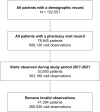Use of machine learning in predicting continuity of HIV treatment in selected Nigerian States
- PMID: 40273279
- PMCID: PMC12021289
- DOI: 10.1371/journal.pgph.0004497
Use of machine learning in predicting continuity of HIV treatment in selected Nigerian States
Abstract
Nigeria, with the second-largest HIV epidemic globally, faces challenges in achieving its HIV epidemic control goals by 2030, with interruptions in treatment (IIT) a significant challenge. Machine learning (ML) models can help HIV programs implement targeted interventions to improve the quality of care, develop effective early interventions, and provide insights into optimal resource allocation and program sustainability. This paper aims to identify predictors and measure the performance of models used to predict the risk of IIT among People Living with HIV (PLHIV) on antiretroviral therapy (ART). We trained multiple supervised ML algorithms on de-identified client-level electronic medical records data from a cohort of PLHIV across four Nigerian states. Merged demographic, clinic, pharmacy, and laboratory data were included as potential predictor variables in multiple models. The study analyzed data from 41,394 PLHIV, with 266,520 observations receiving treatment across four Nigerian states. The overall IIT rate was 33.7%, ranging from 17.7% in Cross River State to 42.4% in Niger State. The AdaBoost model demonstrated the best performance, with a sensitivity of 69.2%, specificity of 82.3%, F1 score of 0.678, and PR-AUC and ROC-AUC values of 0.563 and 0.843, respectively. Key predictors included PLHIV prior behavior, visit history, and geographic factors, while demographic features played a lesser role. This study highlights the utility of ML, particularly the AdaBoost model, in stratifying PLHIV by the risk of IIT. By leveraging ML, HIV programs can implement data-driven, targeted interventions to improve care continuity. However, further research is needed to address data biases and contextual challenges in resource-constrained settings.
Copyright: © 2025 Ijaiya et al. This is an open access article distributed under the terms of the Creative Commons Attribution License, which permits unrestricted use, distribution, and reproduction in any medium, provided the original author and source are credited.
Conflict of interest statement
MAI, ET, DI, BD, OO, EA, MS, BO, EO, FE, RF, and KC are Jhpiego and ICAP employees who work on the USAID/PEPFAR-funded RISE project. MM, LDV, TM, and SP are with Palindrome Data contracted by Jhpiego and paid with Jhpiego's internal catalyst funds to conduct the analysis. This does not alter our adherence to PLOS ONE policies on sharing data and materials. There are no patents, products in development or marketed products associated with this research to declare.
Figures
References
-
- Federal Ministry of Health N. Nigeria HIV/AIDS Indicator and Impact Survey (NAIIS) 2018: Technical Report. Abuja; 2019.
-
- United States President’s Emergency Plan For AIDS Relief (PEPFAR). Nigeria Country Operational Plan (COP) 2022 Strategic Direction Summary [Internet]. 2022. [cited 2024 Apr 11]. Available from: https://www.state.gov/wp-content/uploads/2022/09/Nigeria-COP22-SDS.pdf
-
- Stafford KA, Odafe SF, Lo J, Ibrahim R, Ehoche A, Niyang M, et al.. Evaluation of the clinical outcomes of the Test and Treat strategy to implement Treat All in Nigeria: results from the Nigeria Multi-Center ART Study. PLoS One. 2019;14(7):e0218555. doi: 10.1371/journal.pone.0218555 - DOI - PMC - PubMed
-
- Etoori D, Wringe A, Renju J, Kabudula CW, Gomez-Olive FX, Reniers G. Challenges with tracing patients on antiretroviral therapy who are late for clinic appointments in rural South Africa and recommendations for future practice. Glob Health Action. 2020. Dec;13(1):1755115. doi: 10.1080/16549716.2020.1755115 - DOI - PMC - PubMed
LinkOut - more resources
Full Text Sources
Research Materials



